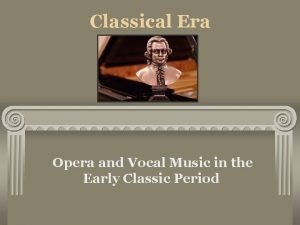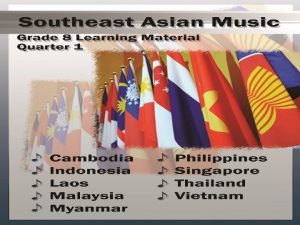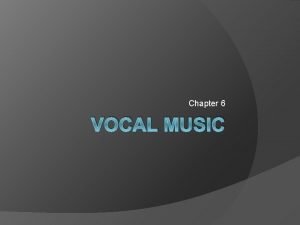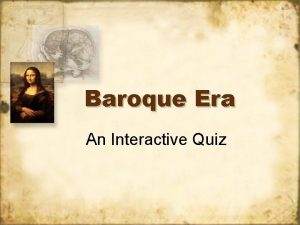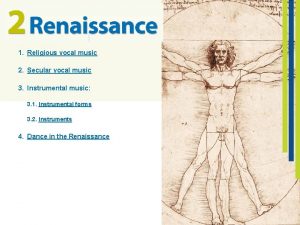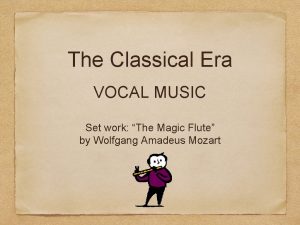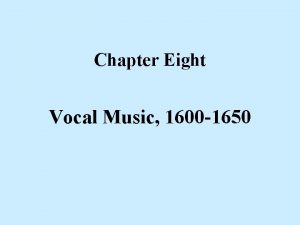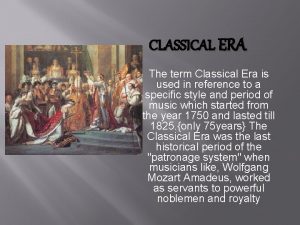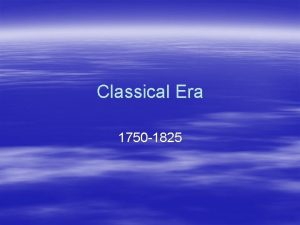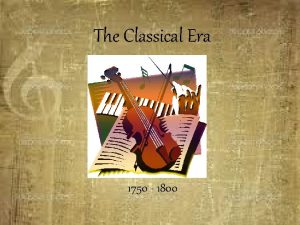CHAPTER 14 Classical Vocal Music Classical Era Vocal












- Slides: 12

CHAPTER 14 Classical Vocal Music

Classical Era Vocal Music Composers focused more on instrumental than vocal music Haydn’s operas rarely performed Beethoven only composed one opera Mozart’s operas & choral works by Mozart, Haydn, & Beethoven significant

Haydn’s Vocal Music • Haydn composed operas for the Esterházy palace, but his operas are nearly forgotten • Masses and oratorios considered Haydn’s vocal masterpieces Masses • Last six Masses, composed between 1796 and 1802, are crowning achievements • Missa in Angustiis also known as the Lord Nelson Mass, • Composed to commemorate Lord Nelson’s naval victory over Napoleon • Written for SATB chorus, soloists, and small orchestra Oratorios • Inspired by Handel’s works. Haydn composed three oratorios • The Creation is the best-know and musically depicts creation of the world • Written for soloists, chorus, orchestra

Classical Opera Genres Opera seria • Italian serious opera • Idomeneo, 1781 Opera buffa • Italian comic opera • Don Giovanni, 1787 • Cosi fan tutti (“Thus do they all”), 1790 Singspiel • German comic opera with spoken dialogue • Die Entführung aus dem Serail (The Abduction from the Seraglio), 1782 • Die Zauberflöte (The Magic Flute), 1791

Many operas sung in Italian, some in vernacular Many audience members knew plots prior to attending performance Modern Era Classical Era Attending an Opera houses place English translations in supertitles above stage Audience members can read plots in program provided prior to performance

Division of Operatic Action Act Scene • Large section of an opera • Operas often have two or three acts • Intermissions often observed between acts • Subdivision of an act • Usually no intermissions taken between scenes Read more about opera in “The Live Experience: Classical and Romantic Opera Singers” (page 145).

Mozart’s The Marriage of Figaro • Opera buffa (comic opera) • Written for soloists, chorus, and orchestra • Based on French play by Beaumarchais, first produced in 1782 • Original plot was controversial – mocked aristocracy • Libretto translated by Lorenzo da Ponte • Mozart and da Ponte turn it into intricate and amusing story involving a pair of lovers, intrigues between servant and master, discovered identity, and a few unlikely coincidences

The Marriage of Figaro Plot Cast of Characters • Count Almaviva, nobleman, baritone • Countess Almaviva, Count’s wife, soprano • Cherubino is countess’ a young man and • Susanna, the is thesoprano count’s page maid, • Role isthe performed mezzo • Figaro, count’sby servant, soprano because tenor’s voice bass would not be light enough • Marcellina, housekeeper, • Known as trouser or pants role soprano in operaa doctor from • Bartolo, Seville, bass • Cherubino, count’s page (soprano singing role of teenage boy) Figaro is engaged to Susanna, but has borrowed money from Marcellina Susanna rebukes and must repay the count’s or marry her romantic advances and the count sides with Figaro’s identity Marcellina to as the kidnapped force Figaro to child of marry her and Dr. Marcellina Bartolo is revealed and Susanna and the thus Figaro does countess plot to not have to marry swap identities to Marcellina trick the count into trying to Happy Ending seduce Susanna • The count falls for again the plot and is exposed • The countess forgives the count • Susanna and Figaro marry • Marcellina and Dr.

Listening Guide: “Non so più cosa con” (“I Don’t Know Who I Am Anymore”) • Opera aria • Mezzo soprano (Cherubino) with Opera aria orchestral accompaniment Mezzo soprano • Homophonic texture (Cherubino) with • ABACC-Coda orchestral • Cherubino falls in love with every woman accompaniment and is confused about his feelings Listening Guide Excerpt from CD 4, track 2, pp. 147 -148 Homophonic texture ABACC-Coda form Text Translation Cherubino inwhat love. I am withdoing, I don’t know who Ifalls am or woman Now I every am on fire or nowand I amisfreezing, confused about his Every woman makes me change color. feelings Every woman makes my heart flutter.

Translation: “Non so più cosa con” (“I Don’t Know Who I Am Anymore”) A Section C Section I don’t know what I am, or what I am doing. Now I am on fire, or now I am freezing. Every woman makes me change color. Every woman makes my heart flutter. B Section When of love there is just a mention I am upset, and my heart beats faster And I find myself talking of love from a need, From a need I can’t explain. I talk of love when walking, I talk of love when dreaming, To the water, to the shadows, to the mountains, To the flowers, to the grass, to the fountains, To the echoes, to the air, to the winds, And the sound of my useless words is carried away with them. Coda And if I don’t have anyone to hear me, I talk of love to myself. Listen to the entire aria:

Listening Guide: “Non più andrai” (“No more will you”), from Le Nozze di Figaro (The Marriage of Figaro) Mozart • Opera Listening Guide Excerpt from CD 1, track 29, pp. 148 -150 aria • Baritone (Figaro) with orchestral Opera aria accompaniment Baritone (Figaro) with • Homophonic texture orchestral • ABACA-Coda accompaniment • Figaro tells Cherubino how his life will change when he enters the military Homophonic texture ABACA-Coda form Text Translation Figaro tells Cherubino how No more will you, amorous butterfly, his life change in the Flit around thewill castle night and day, military all the pretty girls, Upsetting Love’s little Narcissus and Adonis.

Translation: “Non più andrai” (“No more will you”), from Le Nozze di Figaro (The Marriage of Figaro) Mozart A Section B Section No more will you, amorous butterfly, Flit around the castle night and day, Upsetting all the pretty girls, Love’s little Narcissus and Adonis. No more will you have those fine plumes, That soft and stylish hat, Those fine locks, that striking hair, Those rosy, girl-like cheeks. Listen to the A and B sections of the aria:
 Wazn instrument
Wazn instrument Opera & classical vocal music
Opera & classical vocal music Online music portfolio
Online music portfolio Classical music era timeline
Classical music era timeline Periods of music
Periods of music Classical music vs romantic
Classical music vs romantic True vocal folds and false vocal folds
True vocal folds and false vocal folds Vocal music of the romantic period
Vocal music of the romantic period Baroque instrumental
Baroque instrumental Pinpeat
Pinpeat 6 kinds of vocal music
6 kinds of vocal music Characteristic of renaissance music
Characteristic of renaissance music Quiz 2 the baroque era
Quiz 2 the baroque era

